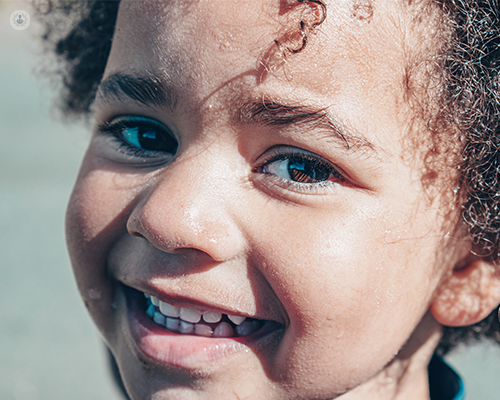All about cataracts in children
Escrito por:Cataracts are a common eye condition characterised by the clouding of the lens, which is the clear, flexible structure located behind the iris and pupil. This clouding interferes with the passage of light into the eye, causing blurry or hazy vision.
They can also affect children. Here to tell us all about it, is leading consultant ophthalmologist Mr Paul Haigh.

Can children develop cataracts?
Yes, although cataracts are more commonly associated with aging, they can also occur in infants and children. Childhood cataracts, also known as paediatric cataracts, may be present at birth (congenital) or develop during childhood (acquired).
What causes cataracts in children?
Congenital causes
Congenital cataracts may result from genetic factors, maternal infections during pregnancy (such as rubella), metabolic disorders or exposure to certain medications or toxins while in the womb.
Acquired causes
Acquired cataracts in children may be caused by trauma to the eye, inflammation, certain medical conditions (such as juvenile arthritis or diabetes), or prolonged exposure to ultraviolet (UV) radiation.
How are cataracts in children diagnosed?
Cataracts in children are typically diagnosed through a comprehensive eye examination performed by an ophthalmologist. This examination may include visual acuity testing, pupil dilation, and examination of the lens using specialised instruments.
What are the symptoms of cataracts in children?
Symptoms of cataracts in children may vary depending on the severity and location of the cataract. Common symptoms include:
- Blurry or cloudy vision
- Poor visual acuity
- Sensitivity to light
- Abnormal eye movements (strabismus)
- White or grey pupil (instead of black)
How are cataracts in children treated?
Surgery
The primary treatment for cataracts in children is surgical removal of the cloudy lens, followed by placement of an artificial lens implant (intraocular lens, or IOL) to restore clear vision. This procedure, known as paediatric cataract surgery, is typically performed under general anaesthesia and is highly successful in restoring vision in children.
Corrective lenses
In some cases, corrective lenses (glasses or contact lenses) may be prescribed following cataract surgery to further optimise visual acuity and correct any remaining refractive errors.
What’s involved in paediatric cataract surgery?
Preoperative evaluation
Before surgery, the child will undergo a thorough preoperative evaluation to assess their overall eye health and determine the best course of treatment.
Surgical procedure
During surgery, the ophthalmologist makes a small incision in the eye and removes the cloudy lens. An artificial lens implant (IOL) is then inserted to replace the natural lens and restore clear vision.
Postoperative care
Following surgery, the child will require close monitoring and postoperative care to ensure proper healing and visual rehabilitation. This may include the use of eye drops, follow-up appointments with the surgeon, and vision therapy if needed.
If your child requires expert treatment for cataracts, arrange a consultation with Mr Haigh via his Top Doctors profile.


